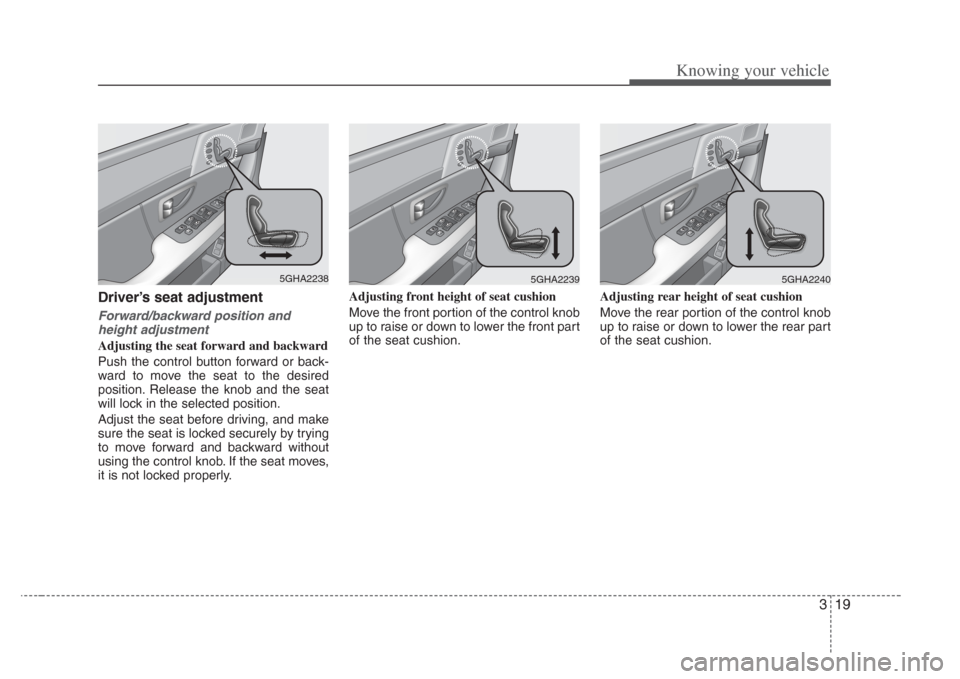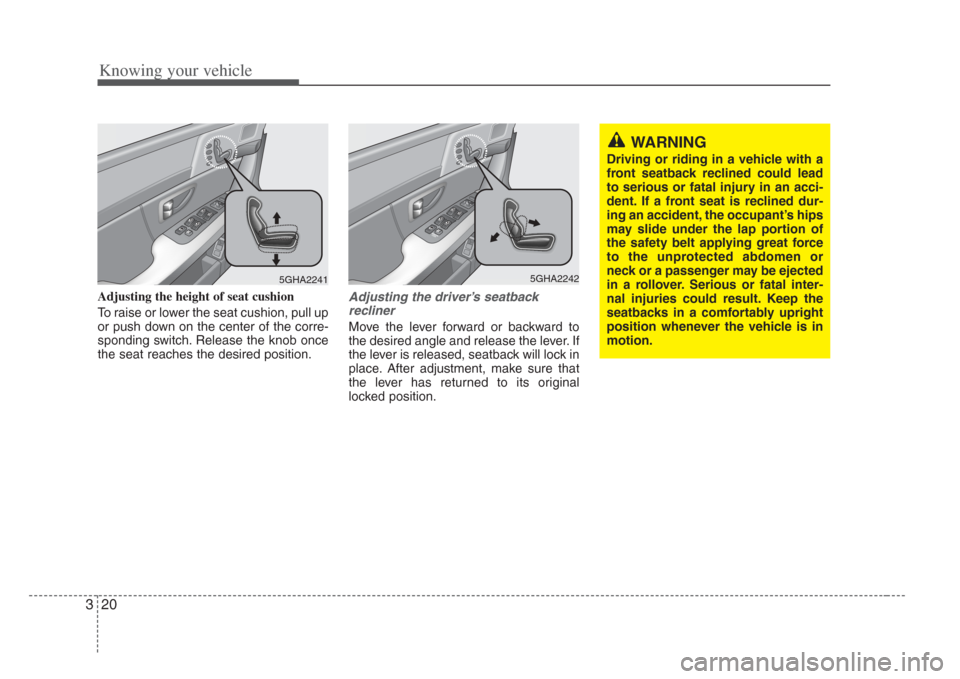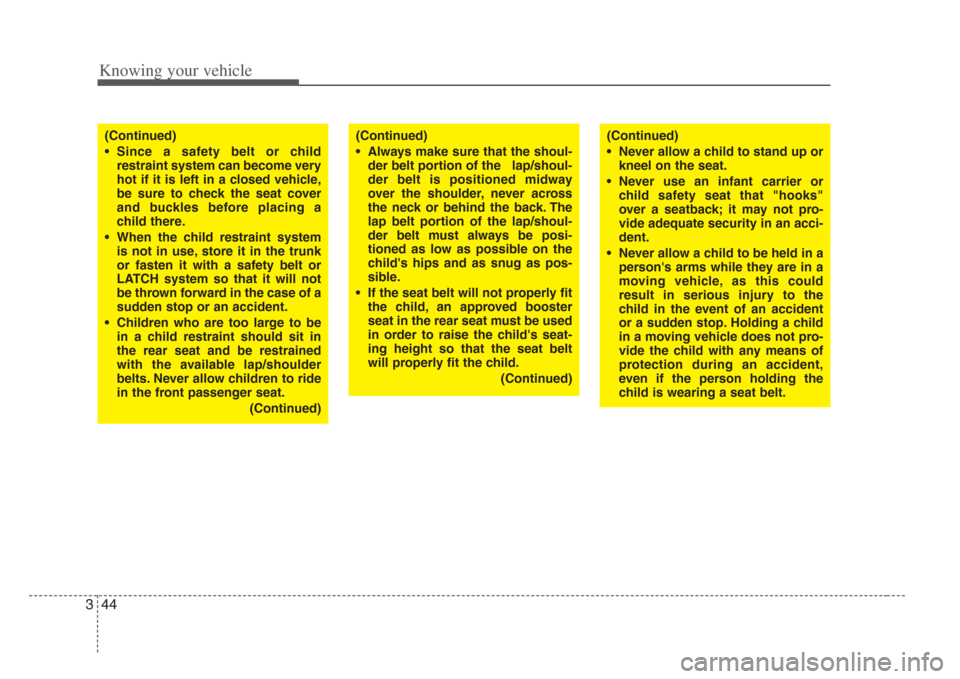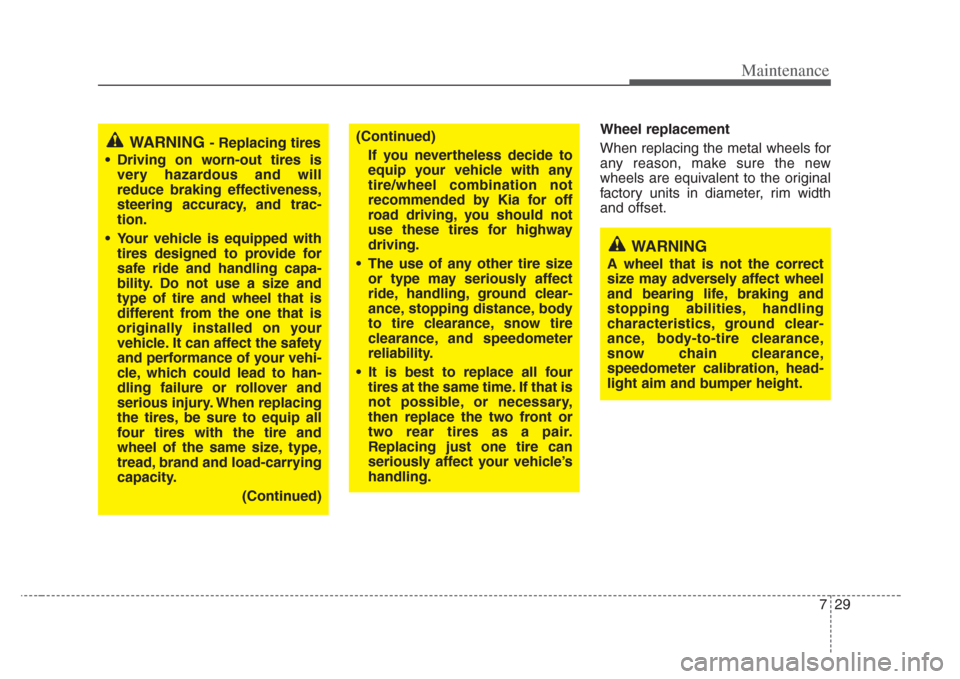2008 KIA Opirus height
[x] Cancel search: heightPage 27 of 283

317
Knowing your vehicle
Driver’s seat
➀
Seat adjustment, forward / back-
ward/height
➁Seatback recliner
➂Seat heater / ventilator switch*
➃Lumbar support
➄Driver position memory system*
■ Headrest adjustment (headrest
cannot be adjusted by a switch)
Front passenger seat
➅
Seat adjustment, forward / backward
\bSeatback recliner
➇Seat heater / ventilator switch*
■ Headrest adjustment (headrest
cannot be adjusted by a switch)
Rear seat
➈
Seat heater switch (left)*
\fSeat heater switch (right)*
* : if equipped
SEATS
STOPSTOP
OGH026012N
Page 29 of 283

319
Knowing your vehicle
Driver’s seat adjustment
Forward/backward position and
height adjustment
Adjusting the seat forward and backward
Push the control button forward or back-
ward to move the seat to the desired
position. Release the knob and the seat
will lock in the selected position.
Adjust the seat before driving, and make
sure the seat is locked securely by trying
to move forward and backward without
using the control knob. If the seat moves,
it is not locked properly. Adjusting front height of seat cushion
Move the front portion of the control knob
up to raise or down to lower the front part
of the seat cushion.
Adjusting rear height of seat cushion
Move the rear portion of the control knob
up to raise or down to lower the rear part
of the seat cushion.
5GHA22385GHA22395GHA2240
Page 30 of 283

Knowing your vehicle
203
WARNING
Driving or riding in a vehicle with a
front seatback reclined could lead
to serious or fatal injury in an acci-
dent. If a front seat is reclined dur-
ing an accident, the occupant’ s hips
may slide under the lap portion of
the safety belt applying great force
to the unprotected abdomen or
neck or a passenger may be ejected
in a rollover. Serious or fatal inter-
nal injuries could result. Keep the
seatbacks in a comfortably upright
position whenever the vehicle i s in
motion.
Adjusting the height of seat cushion
To raise or lower the seat cushion, pull up
or push down on the center of the corre-
sponding switch. Release the knob once
the seat reaches the desired position.Adjusting the driver’ s seatback
recliner
Move the lever forward or backward to
the desired angle and release the lever. If
the lever is released, seatback will lock in
place. After adjustment, make sure that
the lever has returned to its original
locked position.
5GHA22415GHA2242
Page 34 of 283

Knowing your vehicle
243
Headrest adjustment
Adjusting forward and backward
The headrest may be adjusted forward to
three different positions by pulling the
headrest forward. To adjust the headrest
backward, pull it fully forward to the far-
thest position and release it. Adjust the
headrest so that it properly supports the
head and neck.
Adjusting the height up and down
The headrest not only provides comfort
for the driver and passengers, but also
helps protect the head and neck in the
event of a collision.
To raise the headrest, pull it up to the
desired position (
➀). To lower the head-
rest, push and hold the release button
(
➁) on the headrest support and lower
the headrest to the desired position (
➂).
For best protection, adjust the headrest
so its center is as high as your ears. Also
adjust the headrest so its distance from
the head is as wide as your fist.
1GHA2245
WARNING
Pa ssenger s should us e extreme
caution when using seat warmers
due to the possibility of excess
heating or burn s. In particular, the
following types of passengers
should exercise extreme care:
1. Infants, children, elderly or di s-
abled per sons, or hospital outpa-
tients
2. Per sons with sensitive skin or
those that burn ea sily
3. Fatigued individual s
4. Intoxicated individual s
5. Individuals taking medication
that can caus e drowsiness or
sleepiness ( sleeping pills, cold
tablets, etc.)
1GHA2246
Page 36 of 283

Knowing your vehicle
263
Headrest adjustment
Adjusting the height up and down
The headrest not only provides comfort
for the rear passengers, but also helps
protect the head and neck in the event of
a collision.
For best protection, adjust the headrest
so its center is as high as your ears. Also
adjust the headrest so its distance from
the head is as wide as your fist.
To raise the headrest, pull it up to the
desired position (
➀). To lower the head-
rest, push and hold the release button
(
➁) on the headrest support and lower
the headrest to the desired position (
➂).
WARNING
Pa ssenger s should us e extreme
caution when using seat warmers
due to the possibility of excess
heating or burn s. In particular, the
following types of passengers
should exercise extreme care:
1. Infants, children, elderly or di s-
abled per sons, or hospital outpa-
tients
2. Per sons with sensitive skin or
those that burn ea sily
3. Fatigued individual s
4. Intoxicated individual s
5. Individuals taking medication
that can caus e drowsiness or
sleepiness ( sleeping pills, cold
tablets, etc.)
1GHA2254
CAUTION
• When cleaning the seats, do not
use an organic solvent such as
thinner, benzene, alcohol and gasoline. Doing so may damage
the surface of the heater or seats.
• To prevent overheating the seat
warmer, do not place blanket s,
cushions or seat cover s on the
seats while the seat warmer is in operation.
• Do not place heavy or s harp
objects on seats equipped with seat warmer s. Damage to the
seat warming components could occur.
Page 47 of 283

337
Knowing your vehicle
5. Adjust the shoulder anchor position toyour size. To raise the anchor position,
push the anchor up (
➀). To lower the
anchor position, press the button (
➁)
and slide the anchor down (
➂). After
adjustment, make sure the anchor is
locked in position.
To unfasten the front lap/shoulder belt:
Press the release button on the buckle
and allow the belt to slowly retract.
MMSA30265GHN3900
WARNING
• The height adju ster must be in
the locked pos ition when the
vehicle is moving.
• The misadjustment of height of the shoulder belt could reduce
the effectiveness of the seat belt
in a crash.
WARNING
• The seatbacks should always
remain in a comfortable, upright
position while the vehicle is in
motion. The safety belt system
will provide the most protection
with the seatbacks in an upright
position.
• Never wear the shoulder portion of the safety belt under the out-
side arm or behind the back.
• Never wear the shoulder portion of the safety belt across the neck
or face.
• Wear the lap portion of the safety
belt as low on the hips a s possi-
ble. Be sure the lap belt fits snug-
ly around the hip s. Never wear the
lap belt over your wai st.
(Continued)
Page 54 of 283

Knowing your vehicle
443
(Continued)
• Since a safety belt or child
restraint system can become very
hot if it is left in a closed vehicle,
be sure to check the seat cover
and buckles before placing a
child there.
• When the child re straint system
is not in use, store it in the trunk
or fasten it with a safety belt or
LATCH system so that it will not
be thrown forward in the ca se of a
sudden stop or an accident.
• Children who are too large to be in a child restraint should sit in
the rear seat and be restrained
with the available lap/s houlder
belts. Never allow children to ride
in the front passenger seat.
(Continued)(Continued)
•Alway s make sure that the shoul-
der belt portion of the lap/ shoul-
der belt is positioned midway
over the shoulder, never across
the neck or behind the back. The
lap belt portion of the lap/shoul-
der belt mus t always be pos i-
tioned as low as possible on the
child's hips and as snug as pos-
sible.
• If the seat belt will not properly fit the child, an approved boo ster
seat in the rear seat must be used
in order to rai se the child's seat-
ing height so that the seat belt
will properly fit the child.
(Continued)(Continued)
• Never allow a child to stand up orkneel on the seat.
• Never us e an infant carrier or
child safety seat that "hooks "
over a seatback; it may not pro-
vide adequate security in an acci-
dent.
• Never allow a child to be held in a per son's arms while they are in a
moving vehicle, as this could
res ult in s erious injury to the
child in the event of an accident
or a sudden stop. Holding a child
in a moving vehicle doe s not pro-
vide the child with any mean s of
protection during an accident,
even if the per son holding the
child is wearing a seat belt.
Page 264 of 283

729
Maintenance
Wheel replacement
When replacing the metal wheels for
any reason, make sure the new
wheels are equivalent to the original
factory units in diameter, rim width
and offset.
WARNING - Replacing tires
• Driving on worn-out tire s is
very hazardous and will
reduce braking effectiveness,
steering accuracy, and trac-
tion.
• Your vehicle is equipped with tires designed to provide for
safe ride and handling capa-
bility. Do not use a size and
type of tire and wheel that i s
different from the one that i s
originally ins talled on your
vehicle. It can affect the safety
and performance of your vehi-
cle, which could lead to han-
dling failure or rollover and
serious injury. When replacing
the tires, be sure to equip all
four tires with the tire and
wheel of the same size, type,
tread, brand and load-carrying
capacity.
(Continued)(Continued)If you nevertheless decide to
equip your vehicle with any
tire/wheel combination not
recommended by Kia for off
road driving, you should not
use these tires for highway
driving.
• The use of any other tire size or type may seriously affect
ride, handling, ground clear-
ance, stopping di stance, body
to tire clearance, snow tire
clearance, and speedometer
reliability.
• It is best to replace all four tires at the same time. If that is
not possible, or necessary,
then replace the two front or
two rear tires as a pair.
Replacing just one tire can
seriously affect your vehicle’ s
handling.
WARNING
A wheel that is not the correct
size may adver sely affect wheel
and bearing life, braking and
s topping abilities , handling
characteris tics, ground clear-
ance, body-to-tire clearance,
s now chain clearance,
speedometer calibration, head-
light aim and bumper height.